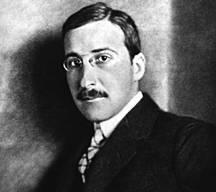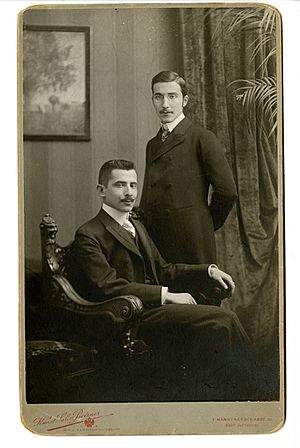Stefan Zweig facts for kids
Stefan Zweig (born November 28, 1881 – died February 22, 1942) was a famous writer from Austria. He wrote many novels, plays, and biographies (life stories of real people). In the 1920s and 1930s, he was one of the most popular writers in the world. His books were translated into many languages.
Zweig grew up in Vienna, Austria. He wrote about important historical figures like Honoré de Balzac and Marie Antoinette. Some of his most famous stories include Letter from an Unknown Woman, Amok, and The Royal Game.
In 1934, because of the rise of the Nazi Party in Germany, Zweig had to leave his home. He moved to England, then to New York, and finally settled in Brazil. He loved Brazil and wrote a book about it called Brazil, Land of the Future. However, he became very sad and worried about the future of Europe. Stefan Zweig and his wife, Lotte, died in their home in Petrópolis, Brazil, on February 22, 1942. His life story, The World of Yesterday, describes what it was like to live in Europe during his time.
Quick facts for kids
Stefan Zweig
|
|
|---|---|

Stefan Zweig, c. 1912
|
|
| Born | 28 November 1881 |
| Died | 22 February 1942 (aged 60) Petrópolis, Rio de Janeiro, Brazil
|
| Alma mater | University of Vienna (PhD, 1904) |
| Occupation |
|
| Known for | The Royal Game, Amok, Letter from an Unknown Woman, Confusion |
| Spouse(s) | Friderike Maria von Winternitz (born Burger) (1920–1938; divorced) Lotte Altmann (1939–1942; their death) |
| Signature | |
Contents
Stefan Zweig's Early Life and Education
Stefan Zweig was born in Vienna, Austria-Hungary. His mother, Ida Brettauer, came from a banking family. His father, Moritz Zweig, was a rich textile maker.
Zweig studied philosophy at the University of Vienna. In 1904, he earned his doctoral degree. Religion was not a main part of his upbringing. He once said that his parents were Jewish "only through accident of birth." However, he did write about Jewish themes in some of his stories.
Zweig was friends with Theodor Herzl, who started the idea of Zionism. Herzl helped publish some of Zweig's early writings. Zweig believed in being a "citizen of the world." He felt that people from different countries should work together.
Life During Wartime and Exile
During World War I, Zweig worked in the Archives of the Ministry of War. He believed in peace, like his friend Romain Rolland.
Zweig married Friderike Maria von Winternitz in 1920. They divorced in 1938. Later, in 1939, he married his secretary, Elisabet Charlotte "Lotte" Altmann, in England.

Because he was Jewish, Zweig was in danger when Adolf Hitler came to power in Germany. In 1934, Zweig left Austria and moved to England. He lived in London and then in Bath. As Hitler's army advanced, Zweig and his second wife moved across the Atlantic Ocean. They settled in New York City in 1940.
On August 22, 1940, they moved to Petrópolis, a mountain town near Rio de Janeiro, Brazil. Zweig became very sad about the situation in Europe. He felt like he no longer belonged anywhere. On February 22, 1942, Stefan Zweig and his wife were found dead in their home in Petrópolis. They were holding hands. He had been very worried about the future of Europe and its culture.
Their house in Brazil is now a cultural center called Casa Stefan Zweig.
Stefan Zweig's Famous Writings
Zweig was a very important writer in the 1920s and 1930s. He was friends with famous thinkers like Sigmund Freud, who studied the human mind. Zweig's books were very popular in the United States, South America, and Europe.
He is best known for his novellas, which are shorter novels. Some of these include The Royal Game, Amok, and Letter from an Unknown Woman. He also wrote longer novels like Beware of Pity.
Zweig wrote many biographies about famous people. These include life stories of Erasmus of Rotterdam, Ferdinand Magellan, and Mary, Queen of Scots. His 1932 biography of Queen Marie Antoinette was even made into a movie in 1938.
Zweig's own life story, The World of Yesterday, was finished just one day before he died in 1942. This book is famous for describing what life was like in Central Europe between 1881 and 1942.
Zweig believed that understanding how the mind works was very important for writers. He wrote to Sigmund Freud that Freud's ideas helped writers "see" and "say" many things they might not have otherwise.
Zweig also worked with the famous composer Richard Strauss. He wrote the story (called a libretto) for Strauss's opera Die schweigsame Frau (The Silent Woman). Strauss bravely refused to remove Zweig's name from the opera's program, even though the Nazi government wanted him to. Because of this, the opera was banned after only three performances.
Stefan Zweig loved collecting old manuscripts, especially original music scores. The British Library has a very important collection of his manuscripts. It includes works by famous composers like Johann Sebastian Bach, Joseph Haydn, and Wolfgang Amadeus Mozart.
Film and TV Adaptations of Zweig's Works
Many of Stefan Zweig's stories and books have been made into movies and TV shows:
- Letter from an Unknown Woman was made into a film in 1948.
- Beware of Pity became a film in 1946.
- The 2012 Brazilian film The Invisible Collection is based on Zweig's short story.
- The French film A Promise (2013) is based on his novella Journey into the Past.
- The 2013 Swiss film Mary Queen of Scots is based on Zweig's biography of Maria Stuart.
- The 2014 film The Grand Budapest Hotel by Wes Anderson was inspired by Zweig's novels. The film even has a character, The Author, who is loosely based on Zweig.
- The 2017 film Stefan Zweig: Farewell to Europe tells the story of Zweig's travels in North and South America as he dealt with being away from his home.
- The 2018 short film Crepúsculo is based on Zweig's short story "A Story Told in Twilight."
- The 1988 TV film La Ruelle au clair de lune is based on Zweig's short story Moonbeam Alley.
See also
 In Spanish: Stefan Zweig para niños
In Spanish: Stefan Zweig para niños
- Le Monde's 100 Books of the Century, a list which includes Confusion of Feelings



